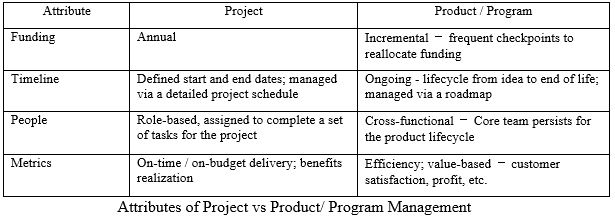
In my last blog, “Agile Transformation: The PMO’s New Paradigm” we covered the significance of embracing different types of work and the role that continuous planning plays in becoming an Agile PMO—but that’s only the beginning. In Part 4, we explore the trend of turning project-focused planning and delivery into a product-centric approach to enable an incremental approach to funding and to increase speed of delivery.
Part 4: The Move to Product-Centric Portfolios
Customer demands are not static; they change as technology evolves and accelerate the pace of innovation. In the whitepaper, The Agile PMO: 5 Steps to Driving Agility at Scale, the focus of the PMO can no longer be on executing on-time and on-budget, but instead on the delivery of value as the outcome. No longer bound to managing the methodology of execution, PMOs must instead work with program managers and new product-centric roles to embrace and support hybrid ways of working to speed delivery. So we’re all on the same page, let’s define products as offerings for external customers while programs focus on internal optimization initiatives.
As your organization transitions toward more agile practices, teams will start thinking in terms of products, rather than projects, to reflect evolving feature sets and ongoing development throughout a lifecycle, as opposed to one-time delivery. As this happens, you’ll start interacting with product managers and product owners as advocates for customers, understanding their needs and incorporating their feedback into product roadmaps.
PMOs need to be ready to make a shift to plan, invest, and manage capacity based on programs, products, and services. All facets should be considered—from the start to initial product delivery and ongoing lifecycle management through sunsetting.
Embrace Product Managers and Owners as Agents of Customer Knowledge
According to the Gartner piece, Survey Analysis: IT Is Moving Quickly from Projects to Products:
About 40 percent of organizations use a product-centric model for software delivery, and that number will double to 80 percent by 2022.
It’s clearly a trend—but one with a solid foundation.
Product managers are responsible for the entire product lifecycle, from ideation to sun-setting, they have the authority to make decisions. It’s their business to understand the demand from customers and key stakeholders and translate that need to convey and manage a product vision and roadmap.
Product owners are responsible for maximizing the value of the product resulting from the development team’s work. They engage with the product manager, program managers, the delivery team and, of course, the PMO to produce a holistic plan that is aligned with current business strategy and can be used to shape future enhancements.
Redefine Success
As your organization is making this transition, agile PMOs should work with program managers, product managers and owners to create portfolio plans and roadmaps. Project schedules can no longer be the PMO’s core focus. Program and product managers depend on the PMO to help them align investments and capacity with company strategy and measure outcomes based on business value.

Adapt Your Funding Approach
PMOs should proactively partner with finance to define a more iterative approach to funding that promotes learn-as-you-go, fail fast experimentation. Product and program approaches, lean-agile delivery models, and lean portfolio management require a change to the way initiatives are funded, evolving from the upfront funding of an entire project. According to Gartner’s Survey Analysis: IT Is Moving Quickly from Projects to Products, organizations transitioning to an iterative funding approach are doing so by platform, product line, and product level.
Dynamic funding enables reallocation within and across programs and products as priorities shift, customers provide feedback and new, promising ideas arise. The agile PMO can associate investments to key results, outcomes, and work to promote more frequent planning. PMOs must also ensure that these iterative funding models fit with other established corporate financial processes and reporting.
Where Do We Go from Here?
Traditional budgeting approaches cannot accommodate the uncertainty, speed, and flexibility needed to drive innovation in products, services, and customer experiences in today’s marketplace. Here, are three steps to help you to move beyond project-based funding and to begin to shift from project to products as an Agile PMO.
- Fund product and programs, not projects: Funding products and programs incrementally and iteratively provides flexibility to allow for experimentation and to adapt to changes in business priorities. Together, PMOs, finance, and business leaders can ensure the organization is allocating funding responsibly to drive the agility and innovation to achieve strategic objectives. Instead of prolonged approval processes that delay time to market, you can shift funding and balance capacity across initiatives through providing visibility into performance, connecting strategy to delivery.
- Guide investments by horizon: This is familiar territory for most PMOs. The concept originated from McKinsey to view portfolio management as having three time horizons: Horizon 1 represents current operations, Horizon 2 is the set of growth opportunities in the pipeline, and Horizon 3 services to incubate ideas and concepts for the future of the organization. Different portfolio criteria and dynamics are associate with each horizon. The organization must be able to plan, analyze, and prioritize investments in the context of these horizons within the entire portfolio.A mix of work types—not just traditional and not just Agile—should be considered as part of the prioritization process. As new demands surface, portfolio priorities must be continually assessed against capacity to determine which combination best meets the organization’s goals. Agile PMOs should evaluate spending in terms of the time horizons of the opportunity, outcomes, uncertainty, and risk of the solutions that teams are trying to create .
- Apply participatory budgeting practices: In keeping with the collaboration needed for business agility, PMOs should consult with product managers, program managers, line-of-business leaders, and executives to ensure investments are aligned with strategy. Many organizations waste too much time and money on manual portfolio analysis and often take on too many initiatives as a result.
PMOs must streamline the budgetary process with the right collaborative tools to incorporate feedback and intelligently analyze ideas in the context of the portfolio. This includes working with executives to gain approvals for iterative funding. As the organization moves toward products and programs, there will be a corresponding shift toward value-based KPIs, such as ROI, Net Present Value (NPV), customer satisfaction, market share, website conversions, and others, as appropriate.
Follow along with this six-part series on the role of the PMO in transforming your organization to becoming an agile enterprise. In the next installment, we’ll bring it all together to give you a holistic view of considerations.
If you haven’t already, we recommend reading parts 1-3 of this series, listed below:
- Part 1: Driving Agile at Scale: The Agile PMO
- Part 2: Agile Transformation Requires Just Enough PMO Governance
- Part 3: Agile Transformation: The PMO’s New Paradigm
We also urge you to read the full white paper The Agile PMO: 5 Steps to Driving Agility at Scale. It provides more detail that we think you’ll find useful.






